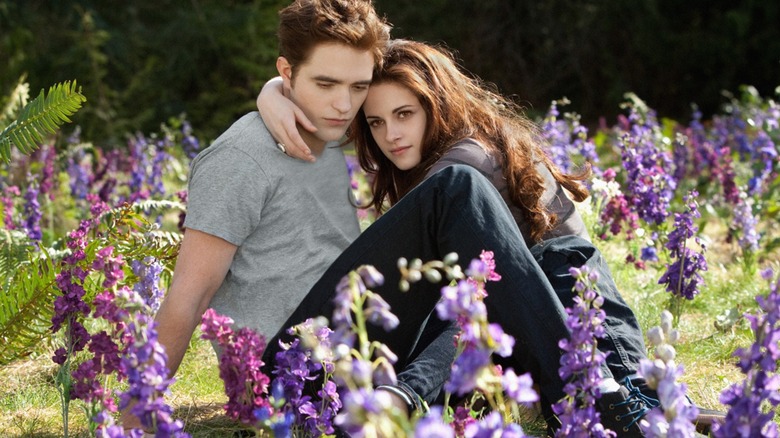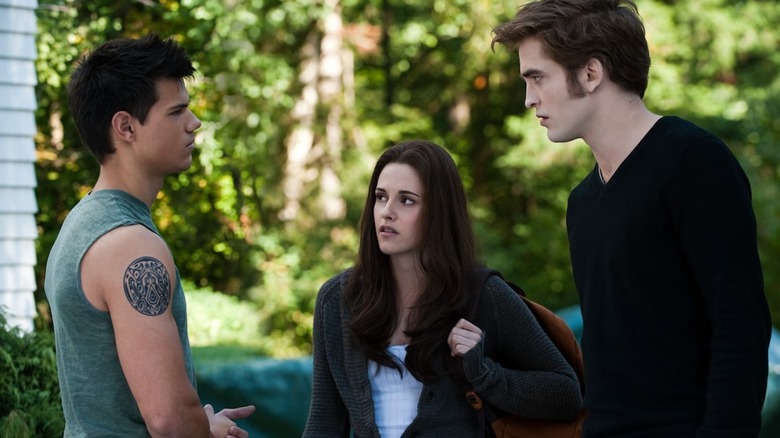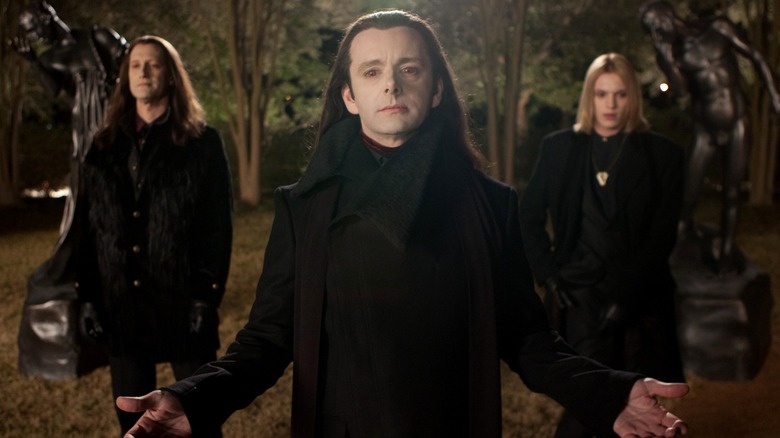The Correct Order To Watch The Twilight Movies
This post contains spoilers for the "Twilight" movies.
"Twilight" is a global phenomenon that warrants no introduction. Whether you love the five-part saga or love to dunk on it, the "Twilight" movies will be forever etched into public consciousness, as its complicated legacy within the context of young-adult fantasy simply cannot be ignored. In hindsight, "Twilight" gifted us with two astoundingly talented and diverse actors — Kristen Stewart and Robert Pattinson, who play Bella Swan and Edward Cullen respectively, and have cemented themselves as performers capable of introducing significant depth to their roles over the years.
The core premise of the "Twilight" movies is pretty simple. An awkward, reserved teenager, Bella, finds herself jammed in an uncharacteristic love triangle, her suitors being a 107-year vampire and a shape-shifting werewolf. Grander stakes are introduced eventually in the form of century-spanning vampire-werewolf rivalry, a rogue, vicious group of vampire newborns who want to watch the world burn, and the eccentric Volturi, the pinnacle of vampire hierarchy. Amid the contrived melodrama and the real threat of the supernatural world being plunged into war, there's a genuine aspect of delightful popcorn entertainment that explains why the "Twilight" films have found a way to endure.
Are there any repercussions to watching the "Twilight" films out of order? Most probably not, as there is no substantial lore that needs to be unpacked at any point, and picking a random installment at will as a formal entry point into the franchise has its silly charm. However, let us dissect the watch order of the films and trace Bella's journey through her adolescence, and how she finds herself in fantastical situations that are downright hellish when perceived objectively.
The only correct watch order for the Twilight Saga
Unless you're feeling experimental, or have accidentally watched a chunk of "Eclipse" on network television without prior context, the best way to watch "Twilight" is in chronological order. Yep, that seems like a no-brainer, as the series has a strict linearity that cannot be creatively jumbled up, and there are no prequels or alternative perspectives offered (except in Stephenie Meyer's original books, where the companion novel "Midnight Sun" recounts the events from Edward's perspective). So, let's start with 2008's "Twilight," which kicks off with Bella moving to Forks, a town that feels as dreary and melancholic as the undead featured in the series.
Here, Jacob Black (Taylor Lautner) is introduced before Edward as Bella's childhood friend, and soon after, Edward and Bella have their meet cute at a shared biology class (where Edward acts dramatically repulsed to her scent, but it makes sense in hindsight). The two eventually fall in love, and Bella's humanity poses a threat to her very life, as a vampire named James (Cam Gigandet) hunts her down. The aftermath of this averted crisis is picked up in "New Moon," where the central lovers undergo a period of separation, allowing Jacob to enter the equation and making matters more convoluted with an inter-species rivalry and vampire politics that dominate the rest of the films.
The next entry, "Eclipse," is the turning point where everything gets serious — this is no longer just about teenage love and fantasy aspirations, as the Cullets and the Quilete have to work together to defeat a common enemy and keep Bella safe. The big bad is defeated and both Edward and Jacob exhibit problematic behavior, but all's well (for now) after Edward and Bella decide to get engaged.
The two-part Breaking Dawn shenanigans
While Meyer's "Breaking Dawn" is a single novel, it was adapted as two films due to the story's convoluted nature and the introduction of new characters who suddenly become integral to the war against the Volturi. However, there are graver issues to navigate here. In "Breaking Dawn — Part 1," Bella becomes pregnant with a hybrid child after getting married and this painful pregnancy seems to be slowly killing her. After the child is born, Edward turns Bella to save her life and she is reborn as a vampire, ready to snap necks and terrorize random hitchhikers due to the newborn hunger she feels.
"Breaking Dawn — Part 2" is an outlier among the "Twilight" films, as it features some of the most genuinely exciting action sequences in the saga, where vampires and werewolves get to yank off limbs and show off their unique powers in a tense battle. Just when things reach a fever pitch, an underwhelming, contrived resolution is offered, which feels hollow for some reason. Then there's the whole Renesmee and imprinting problem. It's something that cannot be justified as a narrative device no matter how you approach it and only adds to the baffling nature of the film's conclusion (which is presented as being a hopeful one).
As for the original books, "Midnight Sun" comes off as a bland retelling of the canon events, failing to offer any fresh perspectives that would deepen our understanding of Meyer's world. However, it is a decent companion material for "Twilight" enthusiasts and infinitely better than "Life and Death: Twilight Reimagined," a gender-swapped retelling of the main story that doesn't reinvent or improve upon the original's core aspects. After all, as fun as it sounds, this is still a world where vampires sparkle under the sun.


